MARKET OVERVIEW
The Global Stevia Market is a significant component in the global arena of natural sweeteners that primarily find force and energy behind such an expansion as the healthy world looks at low-calorie intake for less weight. Being an extremely appealing, zero-calorie sweetener found in the Stevia rebaudiana leaf, the best part for users as well as manufacturers alike to reduce the calorie content while it doesn't decrease the taste level. With the increasing consciousness of health and the changing nature of consumer preference, the Global Stevia Market will play a critical role in addressing the demand for natural plant-based sweeteners across various applications.
The market will be expanded into stevia extracts, powders, and liquid formulations to fit the purpose in the application in food and beverages, pharmaceuticals, and personal care products. This adaptability will help in the use of stevia in different applications like soft drinks, baked goods, dairy products, and dietary supplements. Such adaptation ensures that stevia stays at the top of the favored products by the manufacturers looking forward to filling up consumer demand for clean-label and low-calorie products.
Under this global Stevia market, geographic segments include major areas: North America, Europe, Asia-Pacific, and Latin America, contributing to it individually by differential consumption behaviors of locals, a particular local administration regulation and cultural differences, particularly through Asian areas as Asia and the Pacific-lead share on grounds of China and India-the natives for stevia, though developed cultures can lead its further harvesting in agriculture fields. In North America and Europe, there will be high consumption due to good health awareness along with strict laws on artificial sweeteners.
This Global Stevia Market will cut across the plain product offerings into agricultural practices, supply chain logistics, and the food processing-related technological advancements in the food world. Stevia cultivation will cut across farming communities, especially areas where the crop is grown mainly. New developments in the processes of extraction and purification will help make products from stevia better quality and uniform, making them increasingly appealing to consumers and producers alike. Cooperation between agricultural producers and food technology companies will steer the development course for the market, contributing to sustainability and making production more efficient.
Over the next few years, the Global Stevia Market would witness the involvement of more research and development efforts in terms of improving the taste profile and functional properties of stevia-based products. Consideration would be given to ways of eliminating or reducing the bitter aftertaste associated with stevia, thus expanding its market to more consumers. Agricultural techniques would improve crop yield and quality, so providing a good steady supply of raw materials to meet the rising demand.
Determinative of the global stevia market will also be regulatory frameworks in place. More so, a natural origin advantage will be achieved by stevia, considering there is a current assessment of more sweeteners based on safety and efficacy by governing bodies and organizations around the globe. Nevertheless, regional regulations or standards will influence the acceptance rate of the final product by being adopted widely depending on compliance measures taken by active market participants.
The Global Stevia Market will remain as one of the key players in the natural sweeteners industry, evolving in different ways, because of its widespread applications, diversity in regions, and the room for innovation in this area. As the trends of health and wellness continue, the importance of stevia for offering a low-calorie and natural alternative to sugar will consolidate its place in the global market landscape.
Global Stevia market is estimated to reach $1,392.22 Million by 2032; growing at a CAGR of 11.9% from 2025 to 2032.
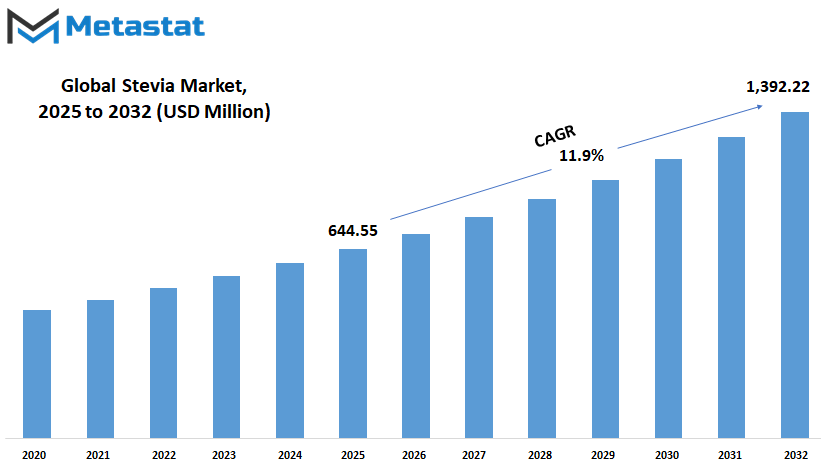
GROWTH FACTORS
The Global Stevia market is expected to witness significant growth in the coming years, mainly driven by health-conscious trends among consumers worldwide. With growing awareness about the adverse health effects associated with excessive sugar consumption, the demand for natural sweeteners like stevia is rapidly growing. The low-calorie variant of sugar made from the plant Stevia rebaudiana, is quite a lucrative attraction to dieters and diabetics for the management of weight gain or diabetic conditions respectively. A general adoption towards healthier lifestyles has been responsible for the most part of the growth in the Global Stevia market.
The most prominent factor, besides this trend, is the ever-increasing application of stevia in the development of low-calorie and sugar-free products. Food and beverage manufacturers innovate in constant pursuit to meet consumer demands for healthier versions of their products which should taste no less tasty. Coming from a natural source and having zero calories, stevia is a perfect ingredient for soft drinks, flavored water, snacks, or desserts. As it gathers more inclusions in numerous products, the market has no other choice but to enlarge even bigger.
Despite this positive trend, issues are likely to affect the growth of the Global Stevia market. Perhaps the main handicap is the bitter aftertaste some consumers suffer when using stevia, especially at higher concentrations. The intensity of the bad taste may also limit its applications in some products since most manufacturers usually try to find formulas that are liked by most people. In addition, the production and extraction costs of stevia are much higher than those of synthetic sweeteners. Such production and extraction activities as cultivation, collection, and refining are relatively more resource- and time-consuming. Such factors will increase the final cost for the end-users and thus may restrict a broader acceptance.
However, the future of the Global Stevia market seems to have promising opportunities. As demand for functional beverages, comprising energy drinks, sports drinks, and health-oriented teas, accelerates, an increase in demand for stevia is expected on the back of improving the market. These drinks appeal to added health benefits. Stevia gets closer to those demands because its natural profile happens to be of that kind. Additionally, as a growth channel in plant-based food products begins to gain strength. After all, more individuals are opting to become vegans and vegetarians, thus upping the stakes for demand of natural plant ingredients like stevia.
The Global Stevia market has some challenges related to taste and production costs, but overall, the prospects are positive. The increasing demand for healthier, natural alternatives to sugar, combined with the expanding role of stevia in innovative product formulations, bodes well for the market. As technology improves the taste profile of stevia and reduces production expenses, its presence in the global food and beverage industry will only grow stronger in the years ahead.
MARKET SEGMENTATION
By Type
The Global Stevia market is expected to go through the most extensive growth in the next years ahead, driven by the ever-increasing demand for natural low-calorie sweeteners. Stevia, a plant-based sweetener, has gained acceptance in society as the healthier option to sugar and artificial sweeteners since it contains zero calorie and has a more natural origin. As health awareness grows throughout the world, more and more consumers seek products that suit healthier lifestyles. Stevia has become a popular product in industries including food and beverages, pharmaceuticals, and personal care.
The Global Stevia market is classified into type as Stevia Leaves, Stevia Extracts, Reb-A (Rebaudioside A), Reb-M (Rebaudioside M), and Stevia Blends. Each different segment plays a unique role in the market’s expansion. Stevia Leaves are valued at USD 82.81 million in 2024, for consumers who prefer products that are less processed and natural. Consumers who prefer traditional, whole-leaf products continue to drive this segment. Stevia Extracts are valued at USD 115 million, widely used in processed foods and beverages due to their concentrated sweetness and ease of integration into different products.
Reb-A, or Rebaudioside A, is one of the most widely used Stevia derivatives, worth USD 228.54 million in 2024. With a high intensity of sweetness and minimal aftertaste, it is widely used in many commercial products. Rebaudioside M, valued at USD 92.05 million, is experiencing increased popularity for its closer approximation to sugar’s taste profile and thus attracting customers seeking a closer approximation to natural sweetness without added calories. Stevia Blends, valued at USD 58.77 million, blend different steviol glycosides or mix Stevia with other natural sweeteners for a balanced flavor profile that will appeal to an even broader group of consumers in search of multiple applications.
Looking ahead, the Global Stevia market is expected to be driven forward by continuous innovation and product development. Companies are investing in new advanced extraction techniques to improve the taste and quality of Stevia-based products so that the bitter aftertaste that some associate with it will not be as much of a concern. With sustainability becoming increasingly a focus of global markets, Stevia’s natural cultivation and environmentally friendly farming practices make it an attractive choice for eco-conscious consumers and businesses.
Since global regulatory bodies approve and promote Stevia, this will further grow its market in the future. Emerging markets for Stevia have been found particularly in Asia-Pacific and Latin America, where high disposable incomes, health, and wellness are taking center stage. With these conditions, the Global Stevia market will continue to increase steadily and to a significant amount, shaping the future of natural sweeteners all over the globe.
By Form
The Stevia market is expected to rise gradually over the next few years, supported by the increased demand for natural sweeteners as people become more conscious of healthy eating. Stevia, a plant-based sugar substitute that contains zero calories, is increasingly popular because it gives sweetness without the aftertaste associated with artificial sweeteners or the negative effects of simply using sugar. This factor is set to continue, forcing the market ahead, as consumers continue to demand healthier options in their diets.
The global Stevia market has been segmented, by form, into powder, liquid, and leaf form in order to provide for the unique needs of consumer groups and other industries. Among these, powder form is found to be primarily used in food and beverage application due to user-friendliness, longer shelf life, and smooth blending property. It mainly finds application in baking, processed foods, and packaged beverages. The demand for low-calorie and sugar-free products is on the rise, and the powder is expected to hold a good market share.
Liquid Stevia is another form that is picking up considerably. Some customers prefer to use a speedy and easy way of sweetening their beverages, like coffee or tea. Its concentration makes little go a long way regarding sweetness; hence, it appeals for individual use. Further, with the current trend toward clean-label products, liquid Stevia is increasingly penetrating more natural and organic product lines. It also finds application in the health and wellness industry through dietary supplements and fitness products.
The leaf form of Stevia, though less processed, finds its market within a niche which prefers more natural and less-altered products. It is most frequently consumed raw to make homemade beers or cook by old ways as used locally when Stevia had been used over centuries. Rising consumer consciousness over plant-based diets, in regions with emphasis on sustainability and wholesome lifestyle, may be anticipated in increasing the use of the leaf form.
In the future, the global Stevia market is likely to continue to innovate and expand. More companies are going to add Stevia to their products as more people become aware of the negative impacts of too much sugar in the diet and as the cases of diabetes and obesity continue to rise. With further advancements in food technology, we may witness new forms or blends of Stevia that will make it even more palatable and versatile to a wider range of consumers.
By Application
The global stevia market is expected to experience rapid growth in the near future, primarily due to increasing consumer demand for healthier and more natural alternatives to sugar. Stevia, a plant-based sweetener, is well known for its zero-calorie content and natural origin, which makes it an attractive choice for health-conscious individuals. Alongside the increased realization of adverse effects on health created by excessive consumption of sugar intake, like being obese, being diabetic, or suffering from a heart disease, the popularity and demand for alternatives like stevia are on a rise.
Though this is initially driven by focused health-conscious individuals, the significant food and drink companies are under pressure to shift their formulations along with changing patterns of customers in the market. By application, the global market for stevia can be divided into beverages, bakery and confectionery, dairy products, and dietary supplements.
In these, the demand of beverages will be the largest as more and more companies are including stevia in soft drinks, flavored waters, teas, and even alcoholic beverages. The demand for low-calorie and sugar-free drinks is increased due to a fitness culture and raising awareness about living a healthy lifestyle. Consumers are now more likely to choose products that offer health benefits without compromising on taste, and stevia fits perfectly into this demand.
The bakery and confectionery segment is also likely to make a significant contribution to the market’s growth. Bakers and confectioners are increasingly using stevia to create sweets, cookies, and baked goods that appeal to customers looking to reduce their sugar intake without sacrificing flavor. This shift is especially relevant in regions where regulations around sugar content are becoming stricter, pushing manufacturers to find alternative sweeteners.
The use of stevia also extends to the dairy sector. From yogurts to flavored milk and ice creams, people are developing these products in healthier and tastier ways with the help of stevia. In a society that is gradually turning health-conscious, there is an increasing demand for sugar-free or low sugar content dairy items. Stevia keeps the taste and texture intact and does not contribute to the calorie count of the product, Thus making it suitable for dairy product manufacturers.
Stevia is now also being incorporated into dietary supplements. As individuals become more mindful of health and wellness, consumers are more inclined to take these supplements for superior nutrition. More often than not, stevia is used for flavoring within protein powders, vitamins, and other similar health-related merchandise.
Looking into the future, the global stevia market is expected to grow much more because technologies associated with extraction and production improve the conditions to make stevia cheaper and thereby more available. In this direction, the global trend towards healthier living and regulatory restrictions on sugar content by governments shall continuously boost demand for natural sweeteners like stevia.
By End Users
The global stevia market is anticipated to grow steadily in the future due to rising health awareness and demand for natural sweeteners. Stevia is an extract of the leaves of the Stevia rebaudiana plant that has gained popularity as a sugar substitute because it contains little to no calories with a sweet taste. As more and more people get aware of the risks associated with excessive sugar consumption, including obesity, diabetes, and heart diseases, the preference for healthier alternatives like stevia continues to increase. This trend is influencing all sectors, causing the widespread use of stevia in multiple products.
The global stevia market, by end users, can be segmented into the Food & Beverage Industry, Pharmaceuticals, Dietary Supplements, and Personal Care & Cosmetics. The most prominent segment within this will be the Food & Beverage Industry. As people’s preference for healthy products grows, many food and beverage companies add stevia to their product line to satisfy that demand. Even soft drinks, baked goods, dairy products, and even sauces are being replaced with stevia to remove the sugar without altering the taste. This shift not only aligns with consumer preferences but also helps companies adhere to government regulations aimed at reducing sugar levels in processed foods.
The pharmaceutical industry is also contributing to the growth of the global stevia market. Since stevia is a natural sweetener that has a negligible effect on blood sugar levels, it is gaining popularity as an ingredient in medicines, especially for diabetic patients. It enhances the taste of oral drugs, which makes them more acceptable without incorporating harmful sugars. The emphasis on patient-friendly formulations will further enhance the use of stevia in pharmaceuticals.
Dietary supplements are the other major market segment in global stevia. Health-conscious consumers are not only using stevia as a sweetener but are also realizing the health benefits associated with it, such as antioxidant properties. Therefore, it finds its place as an additive to protein powders, energy bars, and more health-oriented products. The popularity of fitness and well-being is increasing day by day, so will the demand for stevia in dietary supplements.
Personal care and cosmetics industries also help expand the market. Due to its natural origin, potential skin-soothing properties, stevia is incorporated in products like toothpaste, mouthwashes, and skincare formulations. Due to increasing preference of the consumer for natural ingredient-based products, incorporation of stevia into personal care products will rise in the coming years.
Future technological enhancements in the extracting and processing steps may further attract stevia consumers. Improving taste profiles combined with reduced cost of production can make stevia a more suitable substitute for common sweeteners than it is presently. The whole market for global stevia in all end use segments will boom with increasing concern over health benefits and the consumption of natural environment-friendly products.
|
Forecast Period |
2025-2032 |
|
Market Size in 2025 |
$644.55 million |
|
Market Size by 2032 |
$1,392.22 Million |
|
Growth Rate from 2025 to 2032 |
11.9% |
|
Base Year |
2024 |
|
Regions Covered |
North America, Europe, Asia-Pacific, South America, Middle East & Africa |
REGIONAL ANALYSIS
The global market for Stevia is growing steadily, fueled by the increasing demand for natural and healthier sweeteners. With the heightening health-conscious nature of people and the increase in the demand for a move from artificial sweeteners to more natural alternatives like Stevia, the advancement in the coming future is expected. This, in turn, will vary region-wise due to regional dietary preferences, demand and regulatory frameworks, and market dynamics.
The North America Stevia market is gaining considerable momentum and the United States leads the growth curve. US consumers are moving toward low-calorie and natural sweetening solutions, as a growing awareness about obesity and diabetes drives demand for the same. In Canada and Mexico, positive trends are reported in the same regard, wherein the food and beverage industries add Stevia-based products to the portfolios to capture the consumer needs. The future of the Stevia market in this region looks promising, as more companies are investing in research and development to improve Stevia's taste profile and expand its applications.
Europe is another important region in the global Stevia market. Countries like the UK, Germany, France, and Italy are witnessing an increase in the use of Stevia, especially in beverages, dairy products, and baked goods. This demand is fueled by the growing emphasis on reducing sugar consumption, supported by government initiatives and public health campaigns. As regulatory bodies continue to encourage the reduction of sugar in food products, the market for Stevia in Europe is expected to expand further.
The Asia-Pacific region holds a significant share of the global Stevia market and is anticipated to see the fastest growth in the coming years. Such leading countries for the market in Asia are China, India, Japan, and South Korea. Of these countries, China happens to be a single largest manufacturer of Stevia globally. Here also, because of growing awareness concerning health by middle-class masses as well as rise in income level, more consumers are reaching the market and in turn causing greater demand in that region for the product Stevia. Moreover, the Stevia market also receives further boosts from the traditional dietary practices followed in countries like Japan, where natural ingredients are preferred.
Leading countries in South America, contributing to the growth of the Stevia market, are Brazil and Argentina. Stevia, originating from Paraguay, has a long history here with usage going beyond traditional applications. With rising awareness about the health benefits of Stevia among people in South America, the market is likely to expand in food as well as beverage applications in the coming years.
The Middle East and Africa region is also embracing Stevia gradually. GCC countries, along with Egypt and South Africa, are witnessing a growing demand for natural sweeteners with increasing health concerns due to sugar consumption. The market, however is at its nascent stage in this region, but it does have a promising future as awareness spreads and supportive regulatory frameworks for healthier options become prevalent.
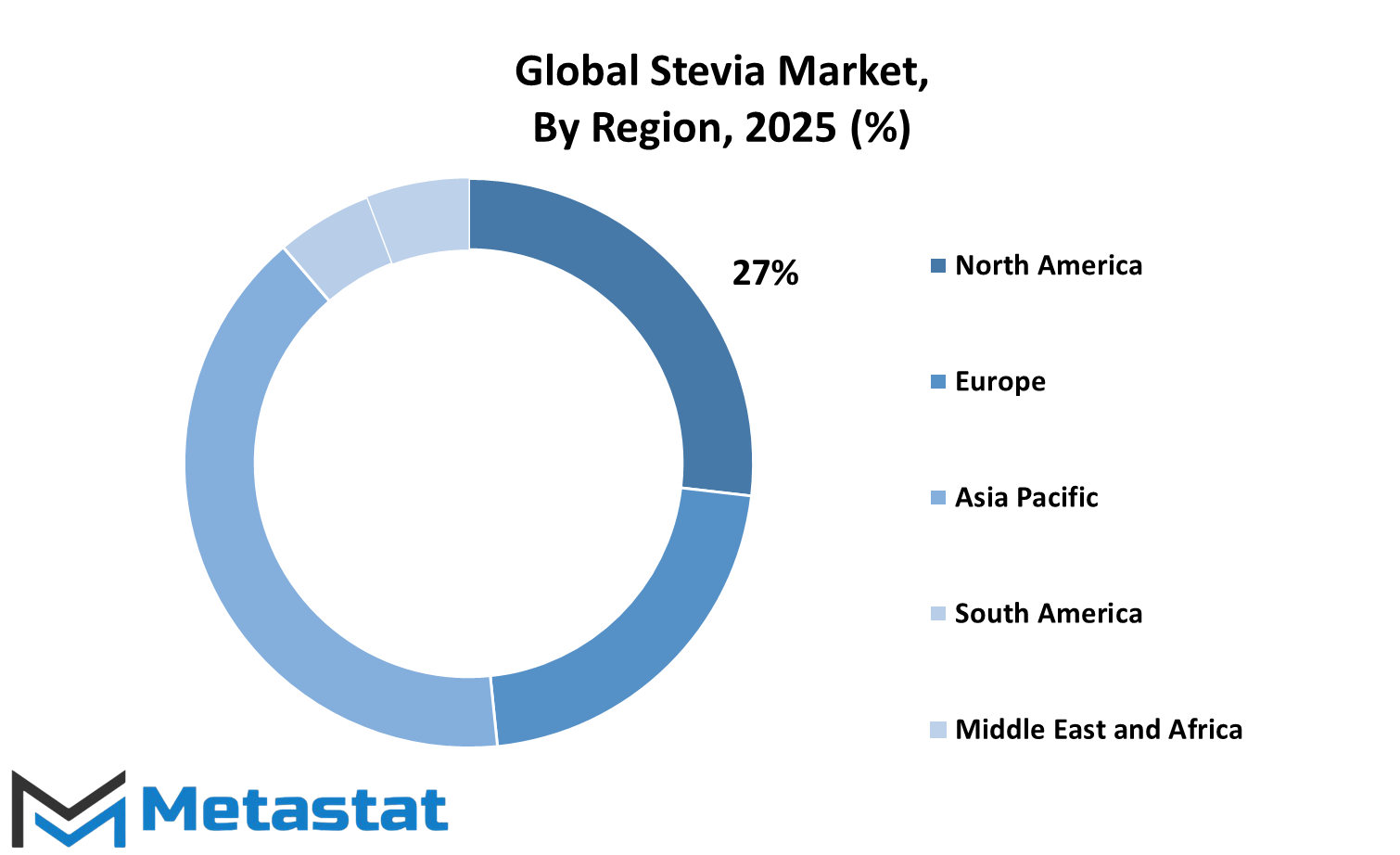
COMPETITIVE PLAYERS
Global Stevia market has been growing steadily due to more and more health awareness and a natural shift towards natural sweeteners. As a consequence of increasing cases of diabetes, obesity, and other health problems, consumers have begun focusing more on their sugar intake, thus increasing the demand for a zero-calorie plant-based sweetener that is stevia. This trend is bound to spearhead the future of the stevia industry, forcing established and new entrants into innovation and changing consumer preferences.
In the global stevia market, some major players that are spearheading include PureCircle, Tate & Lyle PLC, Cargill, Incorporated, GLG Life Tech Corporation, and Archer Daniels Midland Company (ADM). These companies are heavily investing in research and development for the improvement of the taste profile and functionality of stevia products. For example, PureCircle has been in the forefront of developing new stevia blends that reduce bitterness, making the sweetener more appealing to a wider range of consumers. Similarly, Cargill has focused on expanding its product line of stevia to suit various industries from beverages to baked goods.
Added flavor to the competition are Sunwin Stevia International, Inc., Morita Kagaku Kogyo Co., Ltd., and Hunan Nutramax Inc., as it is focusing on improving techniques to produce it, as well as sustainable farming, which could put companies focusing more on sustainability into a competitive lead in the marketplace. Future growth will likely result from an even greater focus on eco-friendly approaches, complemented by improved extraction and formulation techniques for stevia.
The Global Stevia market is going to witness significant collaboration and tie-ups among major players in the next few years. For instance, HTPG, which is a firm, and Zhucheng Haotian Pharma Co., Ltd., another key player, would engage in strategic tie-ups that will strengthen the presence of companies globally. Collaboration would not only share resources but also help distribute their products and services across geographies and newly opened markets.
Layn Natural Ingredients is another major player with a focus on diversifying its product portfolio. Stevia combined with other natural ingredients will meet the demand for clean-label products. Consumers are going to be looking for healthier options, and companies that innovate and provide flexible, high-quality products will win the market. The Global Stevia market is looking bright with innovation, sustainability, and global expansion by key players.
Stevia Market Key Segments:
By Type
- Stevia Leaves
- Stevia Extracts
- Reb-A (Rebaudioside A)
- Reb-M (Rebaudioside M)
- Stevia Blends
By Form
- Powder
- Liquid
- Leaf Form
By Application
- Beverages
- Bakery & Confectionery
- Dairy Products
- Dietary Supplements
By End Users
- Food & Beverage Industry
- Pharmaceuticals
- Dietary Supplements
- Personal Care & Cosmetics
Key Global Stevia Industry Players
- PureCircle
- Tate & Lyle PLC
- Cargill, Incorporated
- GLG Life Tech Corporation
- Archer Daniels Midland Company (ADM)
- Sunwin Stevia International, Inc.
- Morita Kagaku Kogyo Co., Ltd.
- Hunan Nutramax Inc.
- Haotian Pharm Co., Ltd. (HTPG)
- Zhucheng Haotian Pharma Co., Ltd.
- Layn Natural Ingredients
WHAT REPORT PROVIDES
- Full in-depth analysis of the parent Industry
- Important changes in market and its dynamics
- Segmentation details of the market
- Former, on-going, and projected market analysis in terms of volume and value
- Assessment of niche industry developments
- Market share analysis
- Key strategies of major players
- Emerging segments and regional growth potential



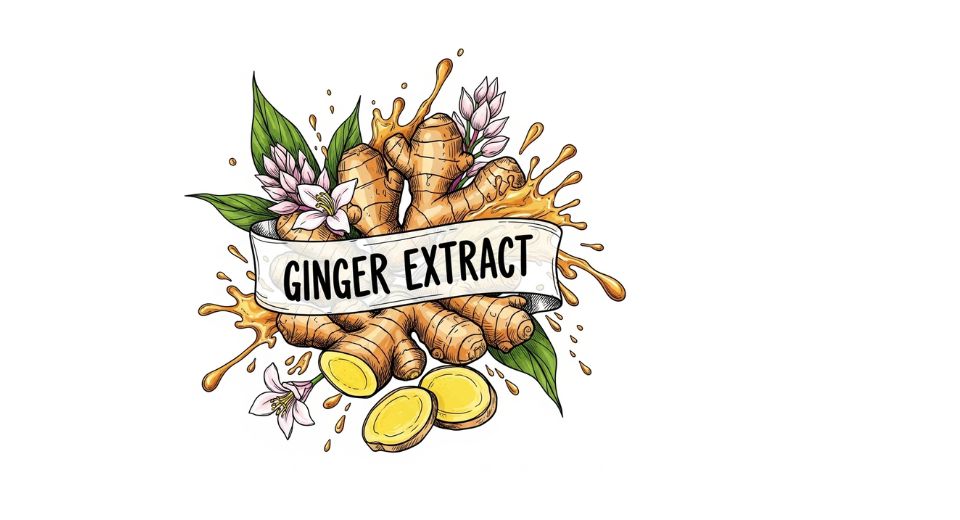

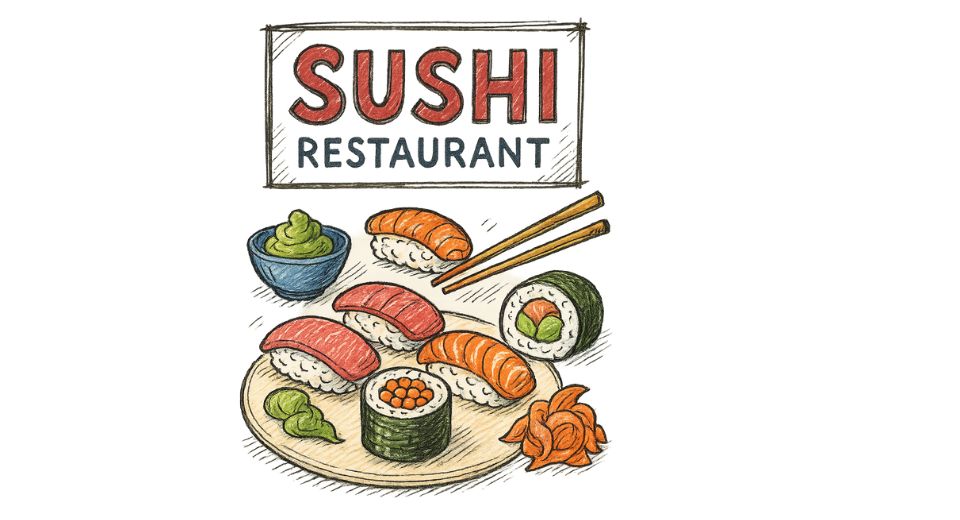
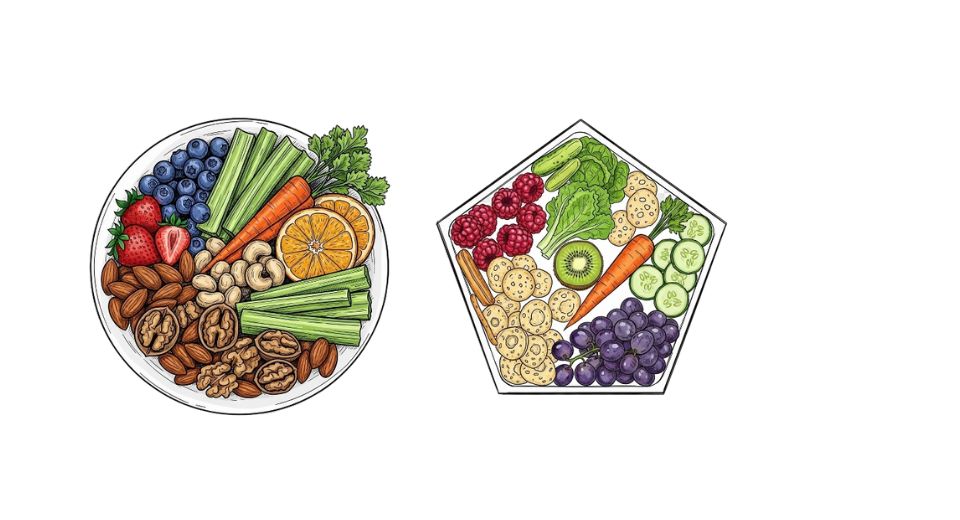

 US: +1 3023308252
US: +1 3023308252






